By Kristina McNitt, Travis Joseph, Rex Storm and Jim James | The Oregonian |Oct. 11, 2020
McNitt is the president of Oregon Forest and Industries Council, Joseph is the CEO and president of American Forest Resource Council, Storm is the executive vice president of Associated Oregon Loggers, and James is the executive director of Oregon Small Woodlands Association.
** This opinion originally appeared in The Oregonian.
When we thought 2020 couldn’t get worse, the windstorm and resulting wildfires from Labor Day created the worst fire season in Oregon history: bigger than the previous record-holding Silver Falls Fire in 1865, bigger than all the Tillamook Burns combined, and bigger than the footprint of degradation left in the wake of the eruption of Mt St. Helens. The enormity of the devastation – more than 1 million acres burned – is hard to absorb. Preliminary analysis indicates almost a third of the total acres in Marion County are within the fire perimeter.
We are all suffering in the aftermath, but the worst impacts fall on those who live, work and play in our forests. Lives have been lost. Homes and businesses burned to the ground. Hundreds of millions of dollars in equipment and property destroyed. Many of our rural, natural resource-based communities and businesses may never recover.
In the face of this ongoing tragedy, Oregon’s forest sector remains resilient, hopeful and determined. We are committed to non-partisan, practical solutions and actions to use controlled fires to reduce fuel loads, protect our fellow citizens from future catastrophic fire events and restore and rebuild the communities and natural places we love.
In the coming months, hundreds of thousands of acres will need to be restored by removing dead trees and regenerating the land to healthy, thriving forests again. We’ll replant, but landowners face a shortage of seedlings due to the unprecedented scale of destruction. Oregon mills will face a shortage of timber supply in coming decades that will test their ability to remain operational and further stress rural communities.
This prolonged environmental, public safety and economic disaster requires the best of Oregon. Already, national media has structured competing, polarizing narratives assigning blame rather than seeking solutions. We ask that Oregonians unite to reject the partisan and false choice between climate change and active forest management. Actively managing Oregon’s forests with proven tools like thinning, logging and controlled burns is a climate solution. The truth is that climate change and lack of forest management on federal forests have both played a role in these severe wildfires.
There is something we can do now to address both.
Carbon emissions from 2020 Oregon wildfires have now surpassed those from each of Oregon’s largest sources of emissions – the energy and transportation sectors. Managing federal forests to avoid mega fires also avoids the carbon emissions choking our communities today. Active forest management helps forests adapt to changing conditions, and healthy, growing trees pull pollution out of the air, capturing that carbon into the wood fiber. When harvested, timber is manufactured into the only building materials that store carbon for the life of the product.
Three elements control wildfire: weather, fuel and topography. The single element that can be mitigated is fuel. Sixty percent of Oregon’s forest is federally owned, yet 86 percent of the acres burned in Oregon in the past decade were on federal land. Excessive buildup of fuels from decades of lack of management have left federal forests overstocked with diseased, insect-ridden and standing dead timber. This cocktail of dangerous conditions leads to catastrophic wildfire when lightning strikes, which further explodes under wind conditions like those experienced over Labor Day.
Reducing fuel loads on federal land can and should be a primary focus. Our public lands managers should be given the policy tools and resources to implement proven, science-based forest management tools like thinning, logging and utilizing controlled burns in the off-season to reduce severe fires and toxic smoke in July, August and September. Smart management also increases forest resiliency, improves access and safety for firefighters and first responders, and supports the livelihoods of thousands of Oregon workers we desperately need to stop and prevent dangerous wildfires.
The forest products sector will continue to be a cornerstone of Oregon’s economy, and we will continue to do what we do best — grow, harvest, and replant new forests while manufacturing carbon-friendly wood products to meet our country’s needs. This is our contribution and the Oregon way – creating green jobs and locally sourced material to rebuild our homes and communities after this tragedy. Thank you to our fellow Oregonians for the tremendous outpouring of support for communities destroyed, indeed some eviscerated, by fire. As an industry, we’re committed to restoration and recovery of our forested landscapes. And we hope as a state, we reset the long-divisive public policy debates and unite around solutions for our collective social, environmental and economic futures.

